- Submissions

Full Text
Orthopedic Research Online Journal
Toronto Extremity Salvage Score and Musculoskeletal Tumor Society Score in the Assessment of Functional Outcomes of Childhood Patients with Malignant Bone Tumors
Kata Jurić Abramović*
Master of Physiotherapy, University of Applied Health Sciences, Zagreb, Croatia
*Corresponding author: Kata Jurić Abramović, Master of Physiotherapy, University of Applied Health Sciences, Zagreb, Croatia
Submission: February 15, 2023;Published: March 09, 2023

ISSN: 2576-8875 Volume10 Issue3
Abstract
Introduction: Malignant diseases of childhood represent one of the most difficult problems of modern medicine and are the second leading cause of death in children under 15 years of age. Bone sarcomas are extremely rare diseases and comprise an average of 6% of all malignant diseases in children. Functional outcomes in patients with malignant bone tumors are assessed with different tests, and the most commonly used tests worldwide are the Toronto Extremity Salvage Score and the Musculoskeletal Tumor Society Score. The aim of this work was to compare the results of the two most common and completely different questionnaires for the assessment of physical function in children who survived malignant bone tumors.
Materials and methods: Measurement of functional outcomes was carried out at the Children’s Hospital Zagreb, and 26 patients participated in the research group. Functional assessment of the physical function of patients treated for bone sarcoma was performed using the Toronto Extremity Salvage Score and the Musculoskeletal Tumor Society Score. Patients included in the study were invited to answer all questions from both questionnaires and all questionnaires were filled out correctly.
Results: No statistically significant difference (p<0.05) was found in the assessment of functional outcomes of patients treated for bone sarcomas using two completely different bone sarcoma questionnaires. The largest number of subjects included in the study had an excellent functional outcome according to the Toronto Extremity Salvage Score of 65.38% of patients, while according to the Musculoskeletal Tumor Society Score this result was 57.69%.
Conclusion: We can conclude that despite certain differences, both questionnaires show a similar assessment of the results, which indicates their mutual importance.
Keywords:Malignant bone tumors; Toronto Extremity Salvage Score; Musculoskeletal Tumor Society Score
Introduction
Primary malignant bone tumors in children and adolescents are mostly rare diseases whose etiology is largely unknown, and on average comprise 6% of all childhood malignant diseases [1,2]. Osteosarcoma and Ewing’s sarcoma are the most common primary malignant bone tumors with an annual incidence of 8.7 per million children [2]. Bone sarcomas in most cases are located in the metaphysis of long bones, especially in the lower extremities in the area around the knee joint, and then in the upper extremities in the proximal part of the humerus [3,4]. In the last forty years, there have been significant advances in the treatment, rehabilitation, and functional assessment of patients with bone sarcomas, which has improved their survival and quality of life. Today, five-year survival averages 70% in children who did not have metastases at the time of diagnosis [5-7]. Since survival has improved so much, and with the knowledge that these are children who want to engage in intensive motor activities, it is important to achieve good functional results after surgery for a malignant bone tumor, despite reduced mobility of the operated joint and extensive soft tissue damage. The majority of authors who investigate functional results after bone sarcoma surgery emphasize good functional outcomes, despite the presence of a large number of complications after surgery, such as implant damage, infection in the surgical area, reduced mobility of the operated joint, muscle atrophy, body balance disorder, torso asymmetry, and associated lateral instability in gait [4,8,9].
Surgical treatment of tumors is highly specialized and the orthopedist is always expected to choose the best modality of surgery for complete removal of the tumor, while at the same time saving the diseased limb by applying various surgical techniques such as en bloc resection of the tumor and installation of an endoprosthesis, followed by the application of allograft, autograft or reimplantation of sterilized bone [10]. The decision on the choice of surgery depends on the localization of the tumor, its extension and the response of the tumor to chemotherapy. Today, amputation is rarely performed, only when the tumor cannot be removed with safe margins, when thrombosis or a pathological fracture is present. Physiotherapy procedures are carried out daily during the treatment of patients, both before and after surgery. Intensive rehabilitation after tumor removal surgery is especially important with the aim of reducing the damage left by the complex operation of a malignant bone tumor, in order to restore the basic functions of the operated part of the body. The physiotherapy program is carried out twice a day for 45 minutes, and includes, in the early phase of postoperative rehabilitation, passive and active exercises to increase the mobility of the operated joint, then exercises to improve muscle strength and endurance, and proprioception exercises. After the completion of medical treatment and rehabilitation, patients are advised to walk for at least one hour a day, climb stairs, engage in some sports activity, but always in agreement with the orthopedist.
Functional assessment in these patients used to be based on the assessment of clinical measurements such as the measurement of the range of motion in the joints with a goniometer, then the assessment of muscle strength using a manual muscle test or research using certain questionnaires on the quality of life. These measurements were not adjusted for a specific disease and the patients did not participate in them, therefore today physical function is most often assessed according to questionnaires for musculoskeletal sarcomas, namely the Toronto Extremity Salvage Score (TESS) and the Musculoskeletal Tumor Society Score (MSTS). TESS is a document of the World Health Organization, it represents the gold standard for assessing function after surgery for muscle and bone tumors, as it has been tested for validity and reliability, and defines disability, handicap, change in physical function depending on the therapeutic intervention and the patient’s need for an aid [10-13]. It is considered that the main advantage of TESS is that the results presented by the medical staff participating in the treatment may be biased, and the patients themselves always report realistically about their functional abilities or limitations [14]. Another globally accepted questionnaire for assessing physical function after medical treatment, surgery, and physiotherapy in children with malignant bone tumors is the MSTS questionnaire, developed by Enneking WF et al. [15] and the assessment is performed by a clinician with partial participation of the patient [15]. This study aimed to compare the results of physical function assessment according to the TESS and MSTS questionnaires in children and young adults who managed to survive malignant bone tumors.
Hypothesis: Assessment of physical function in children with malignant bone tumors using the TESS questionnaire, which contains 30 questions for the lower extremities and 29 questions for the upper extremities, is correlated with the MSTS questionnaire, which has only 6 questions for the lower extremities and the same number of questions for the upper extremities.
Materials and Methods
The study included a total of 26 children and young adult patients with osteosarcoma and Ewing’s sarcoma. Patients with primary malignant bone tumors in the pelvis, lower and upper extremities, of different ages, who had complete medical documentation, were analyzed. The research was retrospective and related to children treated at the Reference Center for Solid Malignant Tumors of Children of the Ministry of Health of the Republic of Croatia at the Children’s Hospital Zagreb from 01.01. 2010 until 31.12. in 2014. In a period of 5 years, 49 patients with bone sarcomas were treated, 39 survived, and 26 patients met the inclusion criteria. All patients or patients’ parents gave written permission to participate in the study, and the research was approved by the Ethics Committee of the Children’s Hospital Zagreb. Inclusion criteria were histologically confirmed diagnosis of osteosarcoma and Ewing’s sarcoma, primary malignant bone tumor located in the pelvis, lower or upper extremities, age between five and thirty-two years of age, proof that the patients did not have any other musculoskeletal disease and that there were no signs return of the disease. Exclusion criteria were inability to understand the Croatian language, cognitive impairment, patients who refused to fill out the questionnaire and incomplete medical documentation. Retrospectively, data related to the number, age, gender of patients, type and localization of tumors, and the modality of surgical treatment in a certain period were collected from the medical records. All patients underwent surgery after 4-6 cycles of neoadjuvant chemotherapy, and after surgery they received another 6 or more cycles of adjuvant chemotherapy.
The TESS questionnaire was created to assess the physical disability of patients primarily after limb salvage surgery, but also after amputation of tumors on the extremities, and everything is based on the patient’s report on his function. Functional difficulties are assessed in the area of activities of daily living, school, work, free time, mobility and sexual activities. The questionnaire contains 29 questions for the upper extremities and 30 questions for the lower extremities. Each response is scored from 1 to 5 points, with 5 being the best performance of the movement or activity and 1 being the worst performance. The final result is expressed as a percentage of the maximum total of points, which is 150 points for the lower extremities and 145 points for the upper extremities. The MSTS questionnaire is based on six questions each for the lower and upper extremities. For the lower extremities, the terms are pain, function, emotional acceptance of the operation, use of aids, ability to walk, and gait pattern, and for the upper extremities, pain, function, emotional acceptance of the operation, hand position, hand dexterity, and ability to lift weight with the operated arm. Each term is marked with a value from 0 to 5 points, where 5 represents the best function, i.e., the highest score for the answer to the question. The values for each category are added up and the functional outcome is presented as the content of the maximum possible sum of points, which is 30.
Statistical data processing
We presented the data tabularly and graphically. Columnar and circular diagrams were used in the graphic display of data. We assessed statistical significance at the level of significance P≤0.05, i.e., with 95% confidence. For numerical data, we tested normality using the Kolmogorov-Smirnov test. As the normality test showed that the distribution is normal, we used parametric tests. For dependent samples, it is the “difference method” in the case of examining the difference of arithmetic means. We examined the correlation between the tests (MSTS and TESS) by calculating the correlation coefficient r. We also expressed the results of the correlation graphically with the help of a scatter diagram. We used the Statistica version 12 application program for data processing, while Excel was used for graphic displays.
Results
Figure 1:Distribution of patients included in the study according to tumor type.
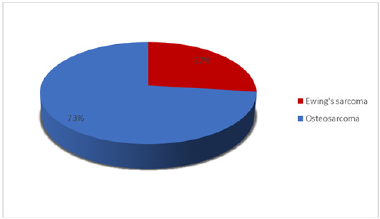
The number of patients who met the criteria for inclusion in the study was 26, and the description of the sample and its basic characteristics are shown in Figures 1,2 & 3. Considering the type of tumor, osteosarcoma dominates in 19 patients (73%), and Ewing’s sarcoma is present in 7 patients (27%) (Figure 1). Bone sarcomas are more common in men, and this is also shown in our study, which included 11 (42%) girls and 15 (58%) boys (Figure 2). The distribution of the patients included in the research related to the age at which the tumor was detected shows that the most patients were between the ages of 10 and 15, a total of 10 patients (38.5%). A significant number of patients were between the ages of 5 and 10, 7 patients (26.9%) and 15 to 20 years, also 7 patients (26.9%). The fewest patients were under the age of 5, only 1 patient (3.8%) and after 20 years, 1 patient (3.8%) (Figure 3). Depending on gender , osteosarcoma in boys is most often located in the distal femur, then in the proximal humerus, proximal tibia, followed by the diaphysis of the femur, proximal femur, fibula and pelvis. In girls, osteosarcoma is most common in the distal femur, then in the area of the proximal humerus, and the proximal tibia and diaphysis of the femur, where it is distributed evenly (Figure 4).
Figure 2:Distribution of patients included in the study by gender.
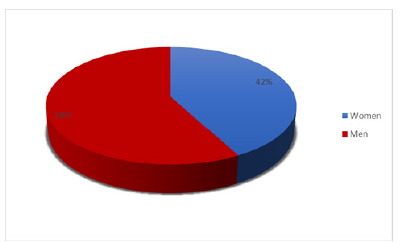
Figure 3:Distribution of patients included in the study according to the age at which the tumor was detected.
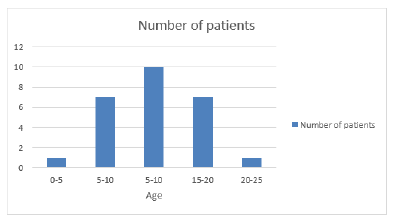
Figure 4:Distribution of patients included in the study according to osteosarcoma localization depending on gender.
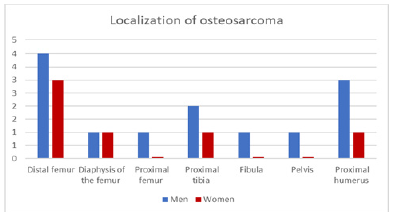
The distribution of patients with osteosarcoma according to the site of tumor development, shown in percentages, shows that the tumor was located in the distal femur in 37% of cases, followed by the proximal humerus in 21%, the proximal tibia in 16%, the diaphysis of the femur in 11%, the proximal femur 5%, the fibula 5% and pelvis 5% (Figure 5). Ewing’s sarcoma in girls is evenly distributed in the pelvis and proximal tibia, somewhat less often in the distal femur, and in boys, it is equally distributed in the area of the pelvis and distal femur (Figure 6). The distribution of patients with Ewing’s sarcoma according to the site of tumor development, shown in percentages, shows that in 42.8% of cases the tumor is located in the pelvis, 28.6% in the distal femur and 28.6% in the proximal tibia (Figure 7). The most common operation was the resection of the tumor en bloc and the installation of a tumor endoprosthesis (Figure 8). 16 (61.5%) patients had en bloc resection with tumor endoprosthesis, autograft 4 (15.4%), allograft 2 (7.7%), amputation 2 (7.7%) and the rest were less common operations.
Figure 5:Distribution of patients included in the study with osteosarcoma according to localization.
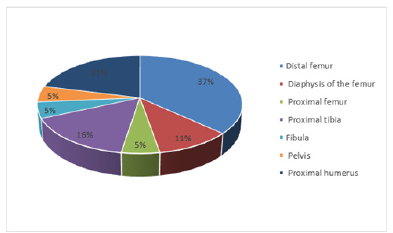
Figure 6:Distribution of patients included in the study with Ewing’s sarcoma according to location depending on gender.
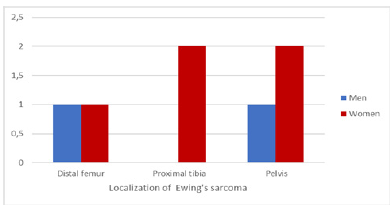
Figure 7:Distribution of patients included in the study according to the localization of Ewing’s sarcoma.
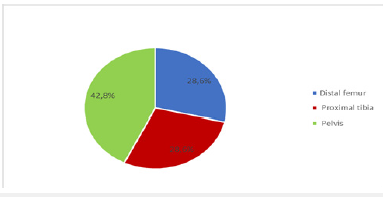
Figure 8:Graphic representation of patients included in the research according to the type of operation.
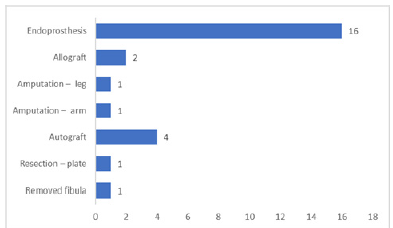
Analysis of patients according to the TESS and MSTS test
We compared the final result of the TESS and MSTS questionnaires, which is expressed as a percentage of the maximum total of points. Table 1 lists the descriptive data for the questionnaires. We made a test for dependent samples, the so-called differentiation method. This test shows the absence of a statistically significant difference between the mean values of individual test percentages (Table 2). We can show the same result graphically using a box plot diagram. In this diagram, the smallest rectangle shows the mean value, the greater variability with the standard deviation, and the handles the interval in which 95% of the results are located (Figure 9). We also examined the correlation between the final results of the two questionnaires. Figure 10 shows a dot diagram from which we can see that the connection is positive and incomplete and the correlation coefficient is r=0.656, which belongs to a good connection. We also examined the significance of the obtained coefficient correlations and obtained a level of statistical significance much lower than 0.05. All-important parameters for correlation are written in the table.
\Table 1: Results of the TESS and MSTS questionnaires presented in percentages of the maximum total points.

Table 2: Differences between the MSTS and the TESS test obtained by the differentiation method.

Figure 9:Statistical presentation of the differences of MSTS and TESS test.
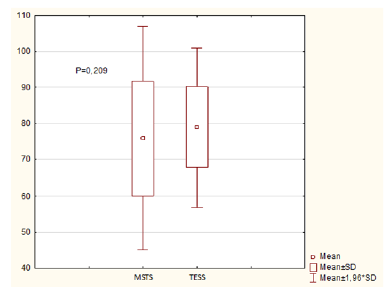
Figure 10:Correlation between MSTS and TESS test.
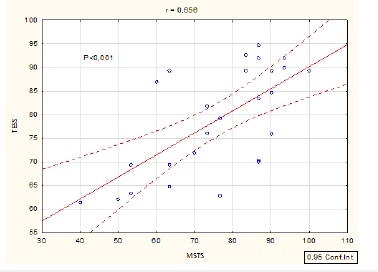
We can conclude that both tests are valid and reliable because they give quite similar results (Table 3).
Table 3: Statistically significant correlation between MSTS and TESS test.

The obtained functional sum of points (score) can be divided
into 4 categories:
A. bad < 25%
B. moderate from 25% to 50%
C. good above 50% to 75%
D. excellent above 75% of the maximum score.
Tables 4 & 5 show the results of our research as the total points of both tests.
Table 4:Total score per MSTS test.
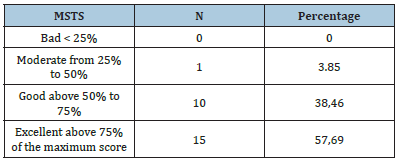
Table 5: Total sum of points per TESS test.
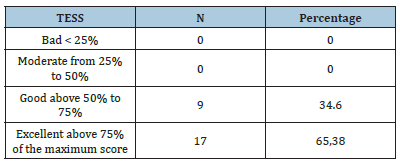
We calculated Spearman’s R and showed a significant association of P=0.004 among the test scores, although there are also some scores that differ in the MSTS and TESS test.
Discussion
Malignant bone tumors are histologically different, there are more than 20 tumor subtypes, and osteosarcoma and Ewing’s sarcoma predominate in children, the rest are rarer tumors.16 Treatment of malignant diseases in children is complex and takes a long time, which makes it difficult for them to reintegrate into the social environment. Bone sarcoma surgery is primarily a form of treatment in which the patient’s life is saved, with the consequence of significant physical disability due to extensive resection or amputation of the limb, where the outcome of treatment in limb-saving surgery and amputation is similar. After surgery, the loss of function depends on the type of tissue removed and its extent. Osteosarcoma is the most common bone sarcoma and in our subjects it comprised 73%, and the second in order is Ewing’s sarcoma with 27%, which is in accordance with previously published studies [16,17]. Statistical processing of the data from our research showed that in patients with malignant bone tumors, there are more patients among the male gender 58% compared to 42% female patients, and this is also confirmed by the research conducted by Mirabelo L et al. [18]. The development time of bone sarcoma in children varies significantly with age, the most cases were between the ages of 10 and 15, 38.5%, and the least under 5 years of age, only 3.8%. The average age of tumor development in children included in our research was 13.4 years, while the research conducted by Sugarski AJ et al. [19] shows a later average age of onset of osteosarcoma, only at 15 years of age [19]. Chaber R et al. [20] published in a study on Ewing’s sarcoma in which 27 patients participated and found that the average age of appearance of this tumor in their subjects was 14 years [20].
Considering the place of development of the primary tumor in our study, osteosarcoma in girls and boys is most often located in the distal part of the femur, which was confirmed by Sun Y et al. [21]. The primary site of development of Ewing’s sarcoma in our patients was most often in the pelvis, and the same finding was published by Ferguson JL et al. [22]. According to the type of operation, the most patients had tumor resection en bloc with endoprosthesis installation 61.5% of patients, followed by the auto graft 15.4%, analog graft 7.7%, amputation 7.7%, fibula removal 3.85%, tibia resection with by installing plate 3.85%, also, a recent study by Galil MM et al. [23] refers to similar results of surgical treatment where 59.26% of patients had limb salvage and 7.4% had amputation, the rest were less frequent operations [23].
The TESS and MSTS questionnaires are the most commonly used tests in the world for assessing physical function in patients with musculoskeletal tumors, which is why they are supported by many studies as an international system for evaluating functional outcomes, especially in tumors of the lower extremities, with the fact that some studies use only one questionnaire, and others both, in order to compare the obtained values [24-26]. These questionnaires are not only used in children, but are also successfully applied in adult patients with benign and malignant bone and muscle tumors in the pelvis and extremities [27,28]. Measurement of physical function after surgery for malignant bone tumors is of great importance in order to evaluate the success of surgical treatment, rehabilitation protocols and improve clinical care for patients.
The TESS questionnaire is designed in such a way that it can be sent by mail, which is important in long-term follow-up of patients and repeated research, on the basis of which it is possible to see how much function improves with a longer period after surgery. The TESS questionnaire was originally developed in English, so far it has been translated into several languages, such as Danish, Portuguese and Dutch [27-29]. In the Netherlands, three translators independently translated the TESS questionnaire into Dutch and created a Dutch version of the questionnaire, with slight adaptations to their culture [27]. They compared the TESS and the Short Form-36 (SF-36) test on a sample of 98 subjects, considering that this comparison is more appropriate than the comparison of the TESS and the MSTS test, since the SF-36 is filled out by the patient himself, and the assessment of the MSTS primarily involves a doctor or physiotherapist [27]. Based on this comparison, they concluded that the TESS questionnaire is valid and reliable and found that 39.6% of patients in their study had an excellent result, while our research shows an excellent result in 65.38% of patients according to the TESS questionnaire and 57.69% according to the MSTS questionnaire. This difference is probably related to the much smaller sample in our study.
In Croatia, we used the original English version of the questionnaire translated into Croatian without special cultural adaptation. Janssen SJ et al. [30] they believe that the TESS questionnaire is more precise in assessing functional outcomes than the MSTS questionnaire, which our research also showed [30]. The MSTS questionnaire is reliable, valid and appropriate, it was developed in 1983 and revised in 1993 [15]. In our research, we used the test from 1993. which has 6 questions, unlike the test from 1983. with 7 questions, and the advantage of the revised test is that it partially includes the patient’s opinion on functional outcomes [15]. The MSTS questionnaire relies on clinical measurements that show damage to the operated joint and other tissues in that area, that part of the test is assessed by the clinician, and the second part is on the patient’s own report on the emotional component of satisfaction with the treatment outcome. Clinical measurements are important, but they are not always related to the patient’s actual functional abilities. According to the current review of the literature, most studies used only one method of assessing functional outcomes, and most experts believe that the application of two or more methods gives more precise results, which our research also showed.
Our study had some limitations, primarily the small number of respondents. In addition, our research was retrograde and we did not have a preoperative assessment of the patient’s functional capabilities. The most severe patients had a poor final outcome and did not participate in the study, which led to a rather high assessment of functional outcomes.
Conclusion
Detailed and extensive monitoring of functional changes after chemotherapy, surgery and physiotherapy in children with malignant bone tumors is necessary, because all this affects their physical and psychosocial health. This study retrospectively compared the benefits of functional assessment of malignant bone tumors in children based on the use of two standard questionnaires for musculoskeletal sarcoma: the MSTS and the TESS test. There is no statistically significant difference between the data obtained by the MSTS and the TESS test, and a statistically significant positive correlation was obtained between these two questionnaires. We can conclude that despite certain differences, both questionnaires show a similar evaluation of the results, indicating their mutual importance. Our research showed a good adaptation of almost all patients with bone sarcoma surgery to physical limitations and despite everything they have a quality life.
References
- Bolling T, Hardes J, Dirksen U (2013) Management of bone tumors in pediatric oncology. Clin Oncol 25(1): 19-26.
- Heare T, Hensley MA, Orfano SD (2009) Bone tumors: Osteosarcoma and ewing's sarcoma. Curr Opin Pediatr 21(3): 365-372.
- Williams RF, Fernandez‐Pineda I, Gosain A (2016) Pediatric sarcomas. Surg Clin North Am 96(5): 1107-1125.
- Morri M, Forni C, Ruisi R, Giamboi T, Giacomella F, et al. (2018) Postoperative function recovery in patients with endoprosthetic knee replacement for bone tumour: An observational study. BMC Musculoskeletal Disorders 19(1): 2280-2287.
- Potratz J, Dirksen U, Jungens H, Craft A (2012) Ewing sarcoma: Clinical state-of-the-art. Pediatr Hematol Oncol 29(1): 1-11.
- Friebele JC, Peck J, Pan X, Abdel-Rasoul M, Mayerson JL (2015) Osteosarcoma: A meta-Analysis and review of the literature. Am J Orthop (Belle Mead NJ) 44(12): 547-553.
- Arndt CA, Rose PS, Folpe AL, Laack NN (2012) Common musculoskeletal tumors of childhood and adolescence. Mayo Clin Proc 87(5): 475-487.
- Qadir I, Umer M, Baloch N (2012) Functional outcome of limb salvage surgery with mega-endoprosthetic reconstruction for bone tumors. Arch Orthop Trauma Surg 132(9): 1227-1232.
- Carty CP, Dickinson IC, Watts MC, Crawford RW, Steadman P (2009) Impairment and disability following limb salvage procedures for bone sarcoma. Knee 16(5): 405-408.
- Davis AM, Wright JG, Williams JI, Bombardier C, Griffin A, et al. (1996) Development of a measure of physical function for patients with bone and soft tissue sarcoma. Qual Life Res 5(5): 508-516.
- Davis AM, Bell RS, Badley EM, Yoshida K, Williams JI (1999) Evaluating functional outcome in patients with lower extremity sarcoma. Clin Orthop 358: 90-100.
- Sugarbaker PH, Barofsky I, Rosenberg SA, Gianola FJ (1982) Quality of life assessment of patients in extremity sarcoma clinical trials. Surgery 91(1): 17-23.
- Piscione J, Barden W, Barry J, Malkin A, Roy T, et al. (2019) The Pediatric Toronto Extremity Salvage Score (pTESS): Validation of a self-reported functional outcomes tool for children with extremity tumors. Clin Orthop Relat Res 477(9): 2127-2141.
- Clayer M, Doyle S, Sangha N, Grimer R (2012) The Toronto extremity salvage score in unoperated controls: An age, gender, and country comparison. Sarcoma 2012: 717213.
- Enneking WF, Dunham W, Gebhardt MC, Malawar M, Pritchard DJ (1993) A system for the functional evaluation of reconstructive procedures after surgical treatment of tumors of the musculoskeletal system. Clin Orthop 286: 241-246.
- Petca RC, Gavrilliu S, Burnei G (2016) Retrospective clinicopathological study of malignant bone tumors in children and adolescents in Romania-single center experience. J Med Life 9(2): 205-210.
- Sheiko M, Bjornson K, Lisle J, Song K, Eary JF, et al. (2012) Physical activity assessment in adolescents with limb salvage. J Pediatr 161(6): 1138-1141.
- Mirabello L, Troisi RJ, Savage SA (2009) International osteosarcoma incidence patterns in children and adolescents, middle ages and elderly persons. Int J Cancer 125(1): 229-234.
- Sugalski AJ, Jiwani A, Ketchum NS, Cornell J, Williams R, et al. (2014) Characterization of localized osteosarcoma of the extremity in children, adolescents, and young adults from a single institution in South Texas. J Pediatr Hematol Oncol 36(6): 353-358.
- Chaber R, Arthur CJ, Lach K, Raciborska A, Michalak E, et al. (2019) Predicting ewing sarcoma treatment outcome using infrared spectroscopy and machine learning. Molecules 24(6): 1075.
- Sun Y, Liu X, Pan S, Deng C, Li X, et al. (2017) Analysis of imaging characteristics of primary malignant bone tumors in children. Oncol Lett 14(5): 5801-5810.
- Ferguson JL, Turner SP (2018) Bone cancer: Diagnosis and treatment principles. Am Fam Physician 98(4): 205-213.
- Galila MM, Fatma EFS, Sherif IA, Iman RA, Khaled YAS (2018) Functional and survival outcome of Egyptian children and adolescents with malignant bone tumors: An experience in a setting of limited health resource. Forum of clinical oncology 9(1): 3-9.
- Aksnes LH, Bauer HC, Jebsen NL, G Follerås, C Allert, et al. (2008) Limb-sparing surgery preserves more function than amputation: A Scandinavian sarcoma group study of 118 patients. J Bone Joint Surg Br 90(6): 786-794.
- Ginsberg JP, Rai SN, Carlson CA, Meadows AT, Hinds PS, et al. (2007) A comparative analysis of functional outcomes in adolescents and young adults with lower‐extremity bone sarcoma. Pediatr Blood Cancer 49(7): 964-969.
- Egmond JC, Bekkering WP, Bramer JAM, Beishuizen A, Fiocco M, et al. (2017) Functional outcome after surgery in patients with bone sarcoma around the knee; results from a long-term prospective study. J Surg Oncol 115(8): 1028-1032.
- Willeumier JJ, Van CW, Van RJ, Dijsktra PS, Vliet TP, et al. (2017) Cross-cultural adaptation, translation, and validation of the Toronto extremity salvage score for extremity bone and soft tissue tumor patients in Netherlands. Sarcoma 2017: 6197525.
- Saebye C, Safwat A, Kaa AK, Pedersen NA, Keller J (2014) Validation of a Danish version of the Toronto extremity salvage Score for patients with sarcoma in the extremities. Dan Med J 61(1): A4734.
- Saraiva D, Camargo B, Davis AM (2008) Cultural adaptation, translation and validation of a functional outcome questionnaire (TESS) to Portuguese with application to patients with lower extremity osteosarcoma. Pediatr Blood Cancer 50(5): 1039-1042.
- Janssen SJ, Paulino NR, Raskin KA, Ferrone ML, Hornicek FJ, et al. (2016) A comparison of questionnaires for assessing physical function in patients with lower extremity bone metastates. J Surg Oncol 114(6): 691-696.
© 2023 Kata Jurić Abramović. This is an open access article distributed under the terms of the Creative Commons Attribution License , which permits unrestricted use, distribution, and build upon your work non-commercially.
 a Creative Commons Attribution 4.0 International License. Based on a work at www.crimsonpublishers.com.
Best viewed in
a Creative Commons Attribution 4.0 International License. Based on a work at www.crimsonpublishers.com.
Best viewed in 







.jpg)






























 Editorial Board Registrations
Editorial Board Registrations Submit your Article
Submit your Article Refer a Friend
Refer a Friend Advertise With Us
Advertise With Us
.jpg)






.jpg)













.bmp)
.jpg)
.png)
.jpg)














.png)

.png)



.png)






